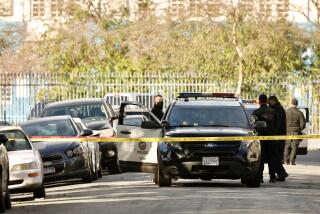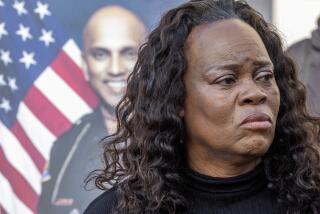Scrutiny in Man’s Death Reflects New View of Police : Arrests: Pasadena barber died in custody while hogtied. Probe reflects new skepticism spurred by King beating.
- Share via
The angry voices filling the New Revelation Baptist Church in Pasadena had a familiar ring.
The crowd of residents from northwest Pasadena demanded: How could a man die in police custody after a routine stop?
Despite explanations from police officials, the residents left the meeting bitter and frustrated that they still had no answer as to why Michael James Bryant died after he was hogtied by Los Angeles police and placed in the back of squad car.
In the end, it all seemed to boil down to their word against that of the police--a situation that has always seemed to favor the police.
But this time their voices were not alone.
Two years after the beating of Rodney G. King in suburban Lake View Terrace and a year after riots tore through Los Angeles, the case of Michael James Bryant, a 37-year-old Pasadena barber, stands as a mirror to a powerful shift in perceptions that has placed the police under intense scrutiny and transformed their relationship with the public.
Soon after the New Revelation meeting, the Pasadena City Council demanded--and got--a federal inquiry into Bryant’s death on March 9. The head of the U.S. Commission on Civil Rights visited to calm an outraged city. The FBI launched an investigation.
Then, as the world press assembled in Los Angeles for the verdicts in the federal King civil rights case, the Bryant incident was reported on NBC.
“There was the mayor on national television!” said Cmdr. Donn L. Burwell, head of the Pasadena Police Department’s investigative division. “No incident has ever reached the level of national news.”
The Bryant case reflects the suspicion in the wake of the King beating that surrounds police accounts of the incidents.
“Policing will never be the same,” said San Marino Police Chief Frank Wills, whose department was involved in the Bryant incident. “The Rodney King incident is to police what Watergate was to politics.”
With no videotape of the chase and arrest, the precise facts of the Bryant case remain elusive.
One of the few certainties is that Bryant was hogtied and placed face down in the back of a squad car, in violation of a Los Angeles police policy that was enacted in October after another man was asphyxiated in a similar situation.
But of the three police departments involved in arresting Bryant on the night of March 8, only the LAPD had a policy against placing hogtied suspects on their abdomens. In addition, Bryant was placed in a San Marino squad car, further confusing the issue of who was responsible for his safety.
If the police account of the incident is accurate, there were no other violations of police policy. But a central issue in the case is the credibility of the police account, which is contradicted in part by some civilian witnesses. Those witnesses, in turn, often contradict each other.
“It’s a shame that you need a video camera to even come close to identifying the truth,” said Pasadena City Councilman Chris Holden.
*
In its rough outline, the incident that led to Bryant’s death seemed like a haunting echo from the past.
The suspect in this case was an imposing black man, 6 feet, 1 inch tall, weighing 320 pounds and clearly agitated, possibly high on drugs. He led a flashing caravan of squad cars through four cities. When finally caught, he was struck with batons, shocked with a Taser and hogtied by police officers.
According to police, the incident began at 11:10 p.m on March 8 at an empty gas station parking lot in San Marino, when Bryant excitedly flagged down a San Marino officer who was driving by, police said.
Bryant told the officer that his nephew had been kidnaped and was at San Marino’s Lacy Park--an assertion that still puzzles Bryant’s family because his nephew was not missing that night.
Police said Bryant pleaded with the officer to help find his nephew. He kept repeating that he needed to get to the park.
San Marino Officer Mark Fried--a drug-use expert with the department--recognized that Bryant was intoxicated.
He offered to drive Bryant to search for his nephew. When Fried reached to remove the keys from Bryant’s car, Bryant sped out of the gas station, clipping the officer on the knee. The chase began.
What had begun as a simple stop to aid a citizen was escalating.
Dispatchers, unaware of the details of the situation at the gas station, broadcast a call for assistance on a “245,” police code for assault with a deadly weapon--in this case, the car.
Bryant’s Chevrolet Nova led the San Marino police on a zigzagging chase across town and into Pasadena, although he never exceeded 45 m.p.h. on city streets.
By the time Bryant entered the Pasadena Freeway at the south end of Arroyo Parkway in Pasadena, there were three San Marino police cars and four Pasadena cars in pursuit, plus a Pasadena police helicopter.
He got off the freeway at Avenue 60 in Highland Park--within LAPD jurisdiction--and cruised the streets before turning onto Avenue 58, a cul-de-sac that ends at the top of a hill.
Police reports say Bryant climbed out of his car and confronted three San Marino officers, who ordered him to stop. When he approached an officer instead, he was struck two or three times on the torso with a baton.
“Don’t hit me with that stick,” Bryant yelled before continuing his flight.
He vaulted a five-foot metal fence and slid partway down the hillside to a dirt path, where he was confronted by Pasadena and Los Angeles police officers. A Los Angeles police spokesman said Bryant refused orders to stop and was struck again with batons when he approached the officers.
Bryant continued to flee down the hill and tumbled headlong into a chain-link fence, which gave way. He fell down a steep embankment and landed near a small kidney-shaped swimming pool. He jumped in.
Officers who had chased him down the hillside surrounded the pool and, after waiting several minutes, a Los Angeles officer stunned Bryant with a Taser. Bryant walked to the side of the pool and was hauled out.
The barber was handcuffed, but according to police, continued to struggle. He had his ankles tied to his wrists in a procedure police call hobbling or cord-cuffing, but which is more commonly known as hogtying.
Officers from the Los Angeles, Pasadena and San Marino departments carried Bryant to Fried’s police car and placed him in back.
The Los Angeles police have acknowledged that Bryant was laid face down after being hogtied, in violation of an October police directive.
The policy was changed after the family of another hogtied suspect--Tracy Mayberry--settled for $700,000 in damages from the city last October. Officers were directed to monitor the breathing of hogtied suspects and place them on their sides.
But it is uncertain how many of the officers knew of the potential danger at the time. The San Marino Police Department has never used cord cuffs. The Pasadena Police Department had no policy against lying cord-cuffed suspects face down, and its officers were unaware of the danger. The Los Angeles Police Department had its new policy, but officials would not comment on how aware the officers might have been of the change.
Fried of the San Marino Department monitored Bryant’s breathing and pulse. After a few minutes, he noticed Bryant’s pulse had begun to slow. Paramedics, routinely summoned after the use of a Taser, arrived soon afterward.
Fried said to the dispatcher: “He’s faking like he’s not breathing. I got a pulse on him.”
An ambulance took Bryant to Los Angeles County-USC Medical Center, where he was pronounced dead shortly after midnight.
*
The questions and outrage over Bryant’s death surfaced immediately. But the civilian witnesses contradict one another in some areas.
Hector Hernandez, 14, said he watched from his balcony and saw Bryant attempt to surrender to officers. “He was standing right there with his hands up,” he said.
But another witness, who did not want his named used, said he only saw a man fleeing police and no indication that Bryant wanted to surrender.
Witness Teresa Ramirez said Bryant was “dead weight, like a sack of potatoes” when he was pulled from the pool. Irma Velez, who lives in the same complex, said Bryant “was struggling and yelling: ‘I’m not doing nothing! I’m not doing nothing!’ ”
As the investigation continued, the Bryant family hired its own pathologist to determine the cause of Bryant’s death. The pathologist found 26 lacerations on the barber’s body--proof, the family says, that Bryant had been beaten by police.
The Los Angeles County coroner’s autopsy described a much smaller number of bruises and cuts, and blamed Bryant’s death instead on cocaine intoxication and the fact that he was hogtied.
Even the three police departments involved have been unable to agree on all points.
Pasadena has maintained that it was only assisting in the case; it was the LAPD officers who hogtied Bryant. San Marino also has pointed toward the LAPD, saying its officers were unaware of the potential danger. The LAPD has responded by saying that Bryant was in a San Marino patrol car when his pulse began to slow. “It was a San Marino arrest,” said LAPD Lt. William Hall, who investigates officer-related shootings for the LAPD.
Within days of Bryant’s death, representatives from the Los Angeles, Pasadena and San Marino police departments gathered at the New Revelation Baptist Church in an attempt to explain their involvement.
They were greeted with skepticism from a crowd that demanded the names of all the officers involved and an immediate autopsy.
The city followed with a special meeting on Bryant’s death at All Saints Episcopal Church in Pasadena. This time, the Pasadena department came prepared, bringing the city attorney, a transcription of the dispatcher tapes and a slide show showing the course of the chase.
San Marino police also have released radio transcripts of the incident and the names of its officers.
The LAPD has been more reticent in its release of information, declining comment on some issues, such as whether its officers at the scene were aware of the hogtying policy, because of pending litigation from Bryant’s family.
Burwell of the Pasadena police said the intense scrutiny of the Bryant case has underscored the reality of being a police officer in the post-King era. The attention has had a chilling effect on officers, who are wary of becoming the next ones on trial and sometimes resentful of the media scrutiny.
“I call it creeping paranoia,” he said.
San Marino’s Wills cited the experience of one of his officers involved in the Bryant chase. “People want him tried as a murderer. They’re calling him a racist,” Wills said. “He did everything right and his life has been made a living hell.”
*
Michael Bryant was not unknown to police.
He was a carouser, by most accounts. Residents of the neighborhood say that on Friday afternoons, the shades would go down on the front window of the little barbershop and emissaries would be dispatched for liquor and beer until late in the evening.
Local police officers complain in private about the drug dealers who they said hung out at the barbershop. There was an arrest in 1989 when Bryant was caught walking nude through a neighbor’s back yard.
But in northwest Pasadena, where Bryant grew up and cut the hair of generations of African-Americans, including King, he was well liked and accepted as part of the community.
In his off hours, the jovial barber was accustomed to appearing unannounced at friends’ houses, bringing gifts--T-shirts for the children, a box of jumbo shrimp for the parents.
Friends and customers say that on a typical afternoon, he might lead a discussion of high school football, joke about the foibles of his regulars or, on a sudden whim, leave a customer sitting to take a spin in somebody’s brand-new Lincoln.
“There were times when he was a good citizen, times when he was a bad citizen,” said Bryant’s friend Sidney Mitchell. “He was human.”
Bryant’s family has filed claims of more than $20 million with the cities of Los Angeles, Pasadena and San Marino, charging that he wrongfully died in police custody.
But the suit and myriad investigations may never provide a satisfactory resolution to those most closely involved.
“They killed him--murdered him, use any word you want--when they hogtied him and threw him in the back seat,” Bryant’s cousin Beverly Mitchell said.
For a week after Bryant’s death, friends and neighbors held a vigil at his tiny barbershop near Lincoln Avenue and Howard Street.
Candles burned on the front steps and fresh bouquets of flowers decorated the steel bars that covered the shop’s front door.
As the weeks have passed, the flowers and candles have faded away. The posters have been removed and today, the only placard left is a “Closed” sign, hanging off kilter on the front door.
The mourners and protesters are gone as well, although months later a fading poster still hangs on a neighboring shop’s grated window.
It reads: “Justice for Michael Bryant and Rodney King.”
More to Read
Sign up for Essential California
The most important California stories and recommendations in your inbox every morning.
You may occasionally receive promotional content from the Los Angeles Times.











